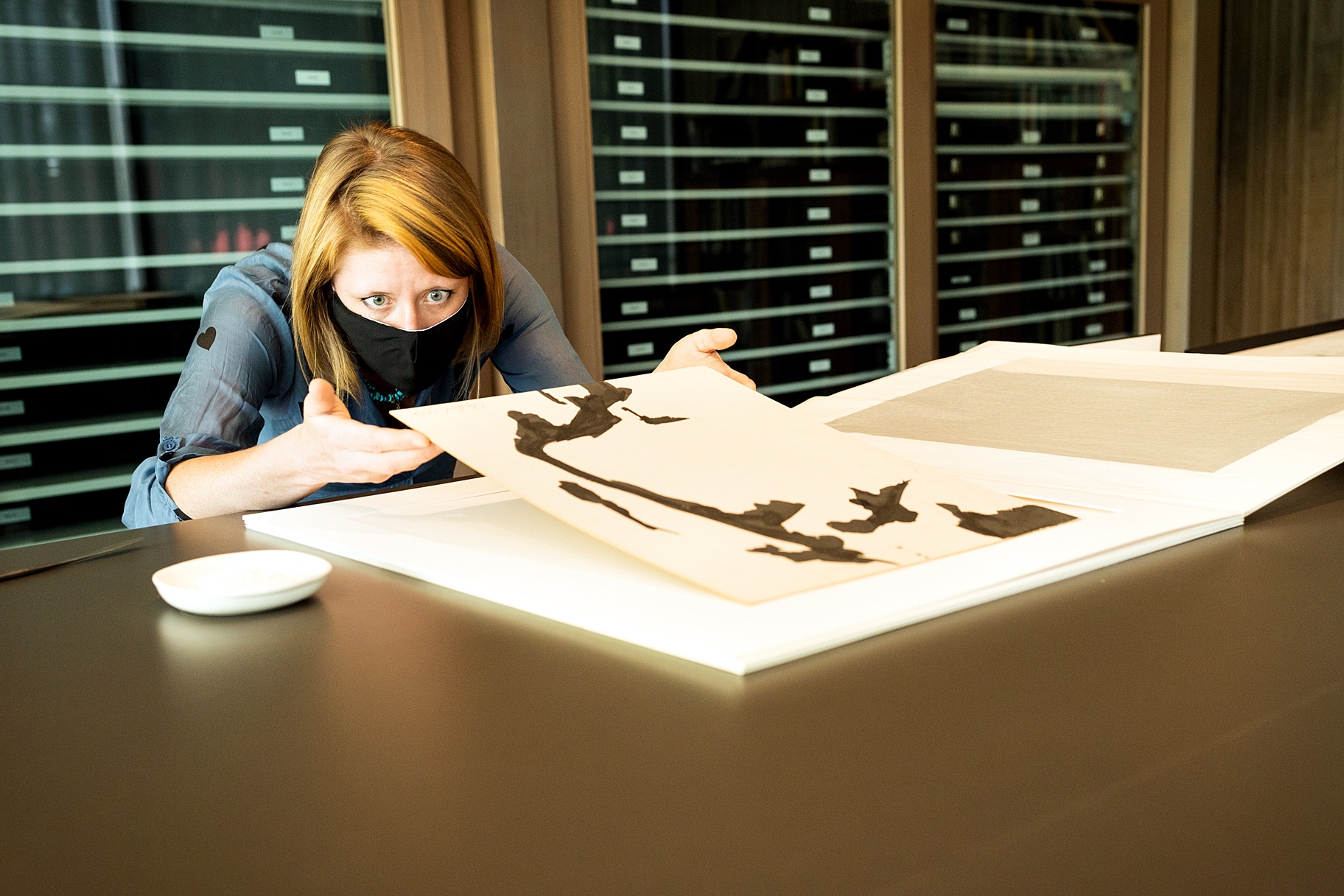//Clyfford Still Museum Assistant Conservator of Paper Michal Mikesell on Aug. 13 demonstrates Clyfford Still’s method for cataloging art piece “PH-508, 1943.” Photos by Karson Hallaway | [email protected]
When abstract artist Clyfford Still passed away in 1980, he bequeathed his wife Patricia Still the task of fully realizing his work. Patricia, better known as Pati, was given a unique stipulation: the city willing to build a single-artist museum would be granted the majority of Still’s collection. More than a dozen cities jockeyed to house the lauded artist’s work. Pati chose Denver.
When the Clyfford Still Museum opened in 2011, it held the vast majority of Still’s work along with archives revealing the secret life of the couple. Valentine’s Day cards, vintage perfume bottles and Pati’s own art were poured over by museum staff searching to better inform the inaugural installation. This coming October, that exhibit will be reimagined under the title “A Decade of Discovery: Clyfford Still in Denver” with a notable addition—a Pati Still watercolor. The painting in question is one of many once used as labels on the exterior of Still’s stored paintings.
“Those watercolors speak to Patricia’s dedication to Still and her love for him and the care for which she documented and wanted to support his legacy, how he couldn’t have done it without all of the support systems,” said Bailey Placzek, the curator of “A Decade of Discovery.”
Pati meticulously documented, photographed and protected Still’s extensive collection following their marriage in 1957. A former painting student of Still’s, Pati was 16 years his junior. According to her diary, she walked away from the first viewing of Still’s work with her body quaking.
As with many women of the era, Pati sacrificed her career in the service of her husband. She spent her days organizing paintings while Still worked furiously and prolifically in their barn. Still even purportedly asked Pati to cease with the watercolor labels. Experts in the field have debated whether this request was rooted in Still’s jealousy regarding the quality of Pati’s paintings. But even with the couple’s archives, it’s impossible to know why Pati shirked her art and why Still asked her to do so.
“A Decade of Discovery” will exhibit only one of Pati’s works, but many others can be viewed in artist Adam Milner’s upcoming book, “Museum of the Invisible Woman.” The volume, to be released later this year, was inspired by the community, specifically the woman, supporting Still.
In many ways, Milner sought to pry Pati from the footnotes of her husband’s life. He features 40 of her watercolors in his book. He had her pink suit recreated and was photographed outside the museum wearing it. But the most haunting of what he calls acts—which could be labeled as performance art—used Pati’s perfume. While being recorded for posterity’s sake, Milner passed from room to room of the museum while spritzing the scent of Pati Still.
In a recent Zoom conversation with Placzek, Milner said the act and his elevation of Pati’s work were birthed by a desire to strip away the artist’s ego. He said the persona that Still carries of the loner, a bad boy fighting against the art world was problematic when held up against his multitude of support.
“[The Stills] started to form one identity, which, in this case, is the identity called Clyfford Still,” Milner said. “I think they kind of fused their lives completely in a way that I don’t want to romanticize; [the project] is more about acknowledging that he wasn’t alone and he’s still not alone.”
Beyond Pati, there is a small army continuing to toil in the name of Still’s art. Museum Assistant Conservator of Paper Michal Mikesell was an intern during the inaugural exhibition. A decade later, they continue to meticulously unfold creases and whiten yellowed paper, constantly returning to the same questions—What was Still’s intention? Was this tear by design? How stark did he hope this color to be?—all in the name of translating one man’s brilliance.
“Still was a man that believed in his own genius, that was his focus almost above anything else in his life and it shows in instances,” Mikesell said. “Pati was a trained artist herself and she was unbelievably accomplished, incredibly talented.”
As a paper conservator, watercolors fall under their purview. It is through this medium that they first came into contact with Pati’s work.
Mikesell said they feel the tension between the paucity of choices afforded women and Pati’s clear devotion to her husband’s work. They’re looking forward to what new truths emerge from the archives. As Pati’s diaries are further analyzed and her work is displayed to the public, Mikesell sees an opportunity for old narratives to shift.
“At the end of the day she believed in him,” Mikesell said. “It’s wonderful that she supported him but I think that’s only part of the story. Understanding her side of the story will be interesting.”

Senior Conservator of Paintings Pam Skiles says the man’s work has infiltrated her dreams after spending days staring into a melange of canvas and color. She points out that a conservator may be able to lean on their understanding of bananas to touch up an aging still life, but with abstraction, everything is more nuanced. She doesn’t see herself as a link in the chain of women buttressing male artists but rather someone in service of art itself.
Skiles has worked with the Still collection along with the adjoining Denver Art Museum for eight years but has been in the field for 18. While women had been receiving degrees in art history for much of the 20th century, many attended these programs in the search of a husband, not a job. Skiles was a part of the first wave of women developing their own art careers.
“The field of art conservation in the last 20 or 30 years has really heavily skewed towards women,” Skiles said. “It’s not to say that the white male patriarchy isn’t alive and well in museums, because it absolutely is, but women are definitely working their way higher up the administrative chains.”
Abstract maximalist and Creative Director of Babe Walls mural festival, Romelle also sees the merit in contextualizing male artists of yore and continues to be inspired by them. She recently completed a 36-foot mural largely inspired by Still’s use of black. She said the color in his paintings affected the vibrancy around it.
“This idea of perception is contributing to our overall understanding of what we choose to see and what we decide to look for, not only in art but in the world around us,” Romelle said.
She is keenly aware that artistic success is not achieved in a vacuum. It is for this reason that Babe Walls creates spaces for women and nonbinary artists. The annual mural festival featuring 26 artists went on view in July and will be up indefinitely on Arvada’s Rouston trail. All of Babe Walls’s endeavors seek to amplify feminine creativity while promoting collaboration between artists.
Romelle is quick to point out that while men have been centered, there have always been women creating art, and saying now is a “good time for women in art” would discount their contributions. She is excited for women artists of all eras to be celebrated as large institutional museums seek to address this oversight.
“Now is the time to bring forward the people like Pati Still that were always there, they were always making work. It’s time to include them in the conversation they were already a part of.”
Enjoyed this story? Help us keep the lights on! Supporting local press ensures the stories you want to read keep coming, become a member for free today! Click here.





0 Comments